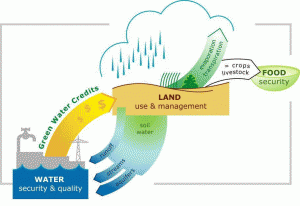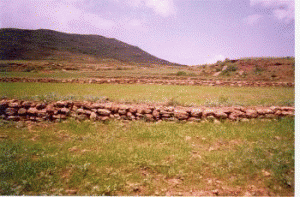Green Water Credits (GWC) can be seen as an investment mechanism for upstream farmers to practice soil and water management activities that generate benefits for downstream water users, which are currently unrecognized and unrewarded. The GWC methodology was applied to the Sebou river basin. Data was gathered, prepared and verified to set up a bio-physical assessment tool to quantify the upstream-downstream interaction in the basin. Three green water management scenarios were analyzed, in order to evaluate the effect of these scenarios on soil evaporation, crop transpiration, surface runoff, sediment inflow into the reservoirs, and groundwater recharge.
Green Water Credits can be seen as an investment mechanism for upstream farmers to practice soil and water management activities that generate benefits for downstream water users, which are currently unrecognized and unrewarded. This initiative is driven by economic, environmental and social benefits. The implementation of GWC has the potential of enhancing overall water management by reducing damaging runoff, increase groundwater recharge, simulate a more reliable flow regime, and reduce harmful sedimentation of reservoirs.

The largest issues in the Sebou basin in Morocco are floods, droughts, erosion and the siltation of reservoirs, food and water security, and public health. These issues offer unique opportunities for the implementation of green water management measures. The implementation of these management options can enhance the water availability and reduce problems related to flooding and erosion. However, farmers need incentives to sustainably implement these measures. At the same time, downstream users may be unaware of the benefits they might gain through farmer implementation of these measures in upstream areas. This Proof-of-Concept phase is meant to demonstrate and quantify the potential benefits to all stakeholders in the basin.
The GWC methodology was applied to the Sebou river basin. Data was gathered, prepared and verified to set up a bio-physical assessment tool (SWAT) to quantify the upstream-downstream interaction in the basin. Three green water management scenarios were analyzed, in order to evaluate the effect of these scenarios on soil evaporation, crop transpiration, surface runoff, sediment inflow into the reservoirs, and groundwater recharge. The GWC scenarios analysed were:
- Stone lines (cordons de pierres)
- Bench terraces (banquette)
- Contour tillage

For the scenarios analyzed, Contour tillage showed the largest decrease in sediment inflow into the reservoirs. The other two scenarios also showed decreases in sediment inflow. Another positive effect is the decrease in surface runoff, and increase in groundwater recharge. The increase in groundwater recharge is especially large for the areas where rainfed broad beans are grown. The increase in groundwater recharge leads to more water inflow into the reservoirs. This increases the water availability for farmers who use the water extensively for irrigation purposes.
By using the SWAT model in combination with WEAP the potential benefits can be assessed. The overall purpose of the WEAP model is to provide a first estimate of the potential impact of the green water management measures. The most effective measures, in terms of benefits only are implementation of bench terraces, followed by carrying out contour tillage, and then constructing stone lines. However, bench terraces are much more expensive than the other two measures, and contour tillage is the most preferable in terms of benefit-cost ratio.

Publicaciones relacionadas
2011 - FutureWater Report 101
Green and Blue Water Resources for the Sebou Basin, Morocco- Soil-Water Management Scenarios using the Soil and Water Assessment Tool (SWAT)
Terink, W., J. Hunink, P. Droogers, H. Reuter, G. van Lynden, S. Kauffman
2011 - FutureWater Report 102
Water Use and Demand in the Sebou Basin, Morocco – A Benefit-Cost Analysis using the Water and Evaluation and Planning Tool (WEAP)
Droogers, P., W. Terink, J. Hunink, S. Kauffman, G. van Lynden

